
Search cheap and promo Turkish Airlines flight tickets here!
Search and book cheap flights with Turkish Airlines
Routes
Schedule
Price from
Register to Use Your Coupon
Diskon 8% Hotel
Diskon s.d 8% Xperience
Diskon 12% Antar Jemput Bandara
Diskon 10% Rental Mobil
Read on and kickstart your adventure
Exciting Flights Promo for You!
Airline Facilities

| Check-in Baggage |
|---|
| 30 kg |

| Cabin Baggage |
|---|
| 8 kg |

| Check-in Time Limit |
|---|
| 1 hour before departure |
Flight Services in Traveloka
Smart Combo
With Smart Combo tickets from Traveloka, you can book premium-service flights at up to 40% off. Enjoy flights with Air France, Cathay Pacific, Etihad, Garuda Indonesia, KLM, Lufthansa, and Singapore Airlines at a more affordable price. All you have to do is find the flights marked Smart Combo, then select the flight that suits your needs
Multi-city Flights
High Flexibility Ticket
Baggage
Seat Selection
In-flight Meal
Refund
Reschedule
Online Check-in
Airport Lounge
Baggage Wrap
Price Alert
Flight Status
About Turkish Airlines
Turkish Airlines: An Introduction
Turkish Airlines, one of the most celebrated prominent airlines in the world, has the fourth largest flight network. The airline offers flights to over 300 destinations across Europe, Asia, Africa and the Americas. Turkish Airlines takes passengers to exotic destinations in its economy and business classes.
Turkish Airlines Seat Class
Economy Class
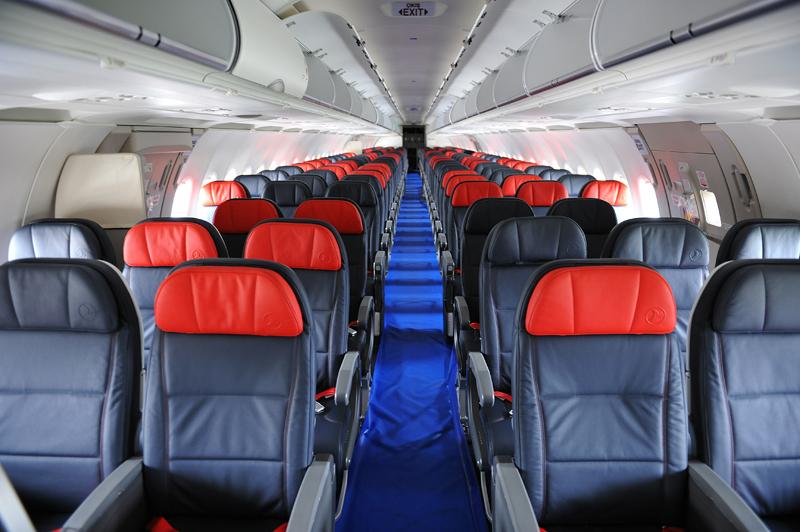
The seats in the economy cabin of Turkish Airlines are 31 – 32 inches wide with a seatback that can recline up to 6 inches and a seat pan that can be moved forward to 1.5 inches, allowing passengers to sit comfortably during both short-haul and long-haul flights. Turkish Airlines also keeps its Economy Class passengers entertained during their flight by providing a range of facilities, from in-flight entertainment accessible through the TV in front of their seats, to a 24-hour WiFipass that the passengers may purchase to stay connected during the flight. Every Economy Class passenger is entitled to 20 kg of baggage. In 2016, the Turkish Airlines Economy Class placed seventh in the World’s Best Economy Class ranking by Skytrax.

In-flight Meal
Turkish Airlines takes pride of the Turkish culinary tradition, hence Turkish cuisines can be found in almost all its flights, including Economy Class. Aside from Turkish cuisines, Turkish Airlines also serves world cuisines onboard its international flights and hot sandwiches on domestic flights. Passengers flying on international routes may also request special meals to meet their medical, dietary and religious restrictions.
Business Class

Turkish Airlines ensures the utmost comfort and convenience for its Business Class passengers both on ground and onboard. Prior to their flight, Business Class passengers can avoid long lines by queueing at the Business Class counter, while during the flight, they can enjoy the airline’s various facilities from the comfort of their seat. Every seat in Business Class includes an ottoman, which makes a 75-inch-long bed when fully reclined. Seats are also equipped with a privacy screen, through which passengers can enjoy various movies, music and games. Business Class passengers are allowed 30 kg of checked baggage and two cabin luggage.

In-flight Meal
Passengers are greeted with welcome drinks as they get onboard a Turkish Airlines flight, where they will enjoy innovative, restaurant-quality dishes served by the airline’s Flying Chefs. Passengers can also expect to find a full bar menu onboard, which mixes both alcoholic and non-alcoholic drinks, including the famous Turkish Coffee. Customized porcelain dinnerware and exclusive glassware are used to serve the meals.
Turkish Airlines Privilege Programs

Miles & Smiles
Miles & Smiles, the frequent flyer program of Turkish Airlines, allows its members to earn mileage from flying with Turkish Airlines and its partners, staying in partner hotels, shopping in Alliance stores, and renting cars from authorized partners. Miles & Smiles Classic cardholders will get 15% more mileage, Classic Plus cardholders will get 25% more, and Elite and Elite Plus cardholders, 50% more.

Aiport Lounge
Access to Turkish Airlines’ airport lounges are granted to Business Class passengers and Miles & Smiles cardholders, who may invite their family or a guest into the lounge. Available in the departure and arrival terminals at Turkish Airlines’ destination airports, the lounge offers such facilities as free WiFi, meeting rooms, food and beverages, newspapers, magazines and prayer rooms, among others.
Turkish Airlines Fleet
Airbus A340-300
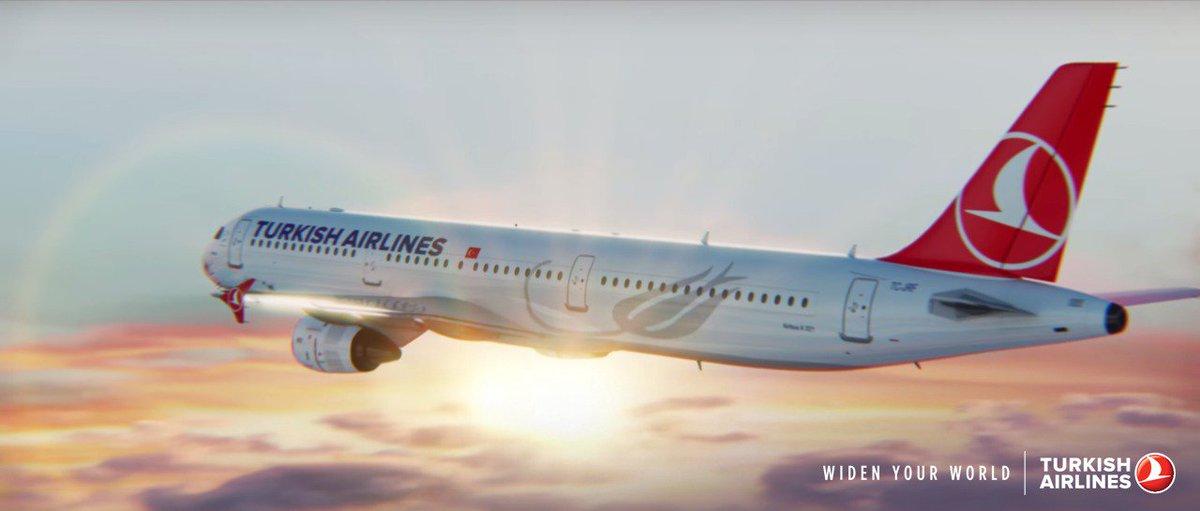
- Economy
- Business
Available
- 2-4-2 (Economy)
- 2-2-2 (Business)
Not Available
- 33 inches (Economy)
- 60 inches (Business)
Available
Boeing B777-300ER
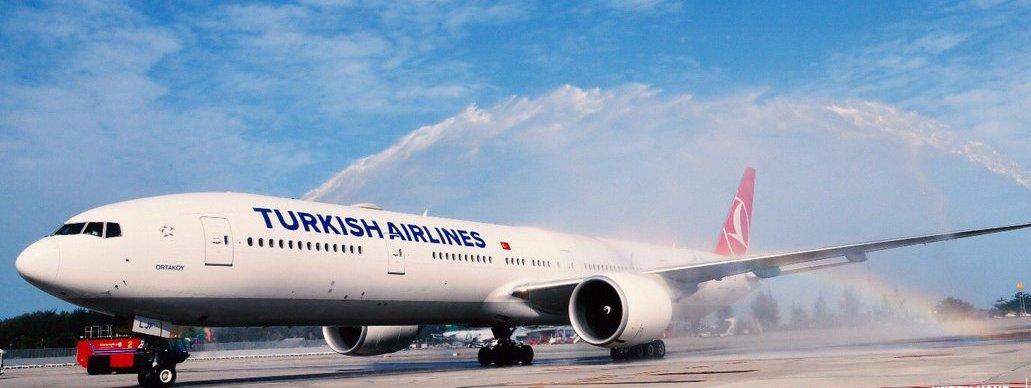
- Economy
- Business
Available
- 3-3-3 (Economy)
- 2-3-2 (Business)
Not Available
- 31 inches (Economy)
- 78 inches (Business)
Available
Turkish Airlines In-flight Crew
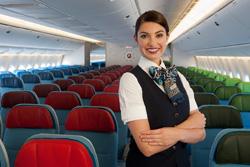
Turkish Airlines Flight Attendant Uniform
The uniform of the Turkish Airlines flight attendants is dominated by the color navy blue. The three-piece skirt suit consists of a blazer, a vest and a below-the-knee straight skirt. The crew wear a white shirt under the three-piece suit skirt. The blazer features a wide peak lapel adorned by golden buttons just below the right and left shoulders and a pin bearing the airline’s code. A blue scarf featuring a modern interpretation of Turkish motifs is tied in a bow-tie fashion around the neck.
Turkish Airlines Baggage Allowance
Flight Route | Seat Class | Cabin Baggage | Checked Baggage |
Domestic | Economy Class | Max. 8 kg (Dimension: 55 x 40 x 23 cm) | Max. 20 kg |
Business Class | 2 pcs (max. 8 kg/pc) (Dimension: 55 x 40 x 23 cm) | Max. 30 kg | |
International | Economy Class | Max. 8 kg (Dimension: 55 x 40 x 23 cm) | Max. 20 kg |
Business Class | 2 pcs (max. 8 kg/pc) (Dimension: 55 x 40 x 23 cm) | Max. 30 kg | |
All flights to America | Economy Class | Max. 8 kg (Dimension: 55 x 40 x 23 cm) | 2 pcs (max. 23 kg/pc) (Dimension: max. 158 cm) |
Business Class | 2 pcs (max. 8 kg/pc) (Dimension: 55 x 40 x 23 cm) | 2 pcs (max. 32 kg/pc) (Dimension: max. 158 cm) |
Turkish Airlines Passenger Policy
Infant Passenger Policy (0-2 Years Old)
- Infants aged 2 days or less are prohibited from flying.
- Infants aged between 2 and 7 days are required to submit a medical certificate, stating they are fit to travel by plane.
- Tickets will be issued for infants, but they will not have an independent seat. Parents and guardians must hold the infant on their lap.
- Infants are prohibited from traveling alone. They must be escorted by an adult aged at least 18 years old.
- Parents or guardians who would like to order baby food for their children must do so during booking or at the latest 24 hours before departure.
Child Passenger Policy (2-12 Years Old)
- Child tickets will be issued for children aged 2 to 12 years old.
- Passengers aged 2 to 7 years old must be escorted by their parent or a guardian aged at least 18 years old.
- Passengers aged 7 to 12 years old can travel alone (Unattended Child Passengers) or with a companion hostess (Attended Child Passengers).
- Parents or legal guardians of Unattended Child Passengers must fill in and sign the Unaccompanied Minors Declaration Form at the check-in counters. The service is available with an additional fee. Unattended Child Passengers will be accompanied by the airline’s staff on ground and by the cabin crew onboard.
- The Unaccompanied Minors service can only be attained if the booking and request are made by the child passenger's parents or a person authorized by the parents.
- Parents or guardians of Attended Child Passengers must fill in and sign the Accompanied Child Transit Authorization Form, in which they specify the language spoken by the child. Requests for this service must be made at latest 48 hours before departure.
- If the child is handed over by someone other than his/her parents or guardians, the person handing over the child must present a notarized Authorization Document.
- The child passenger’s parents or legal guardian must wait in the airport until the plane has taken off.
- Parents and legal guardians bear all cost of the service provided to their child.
Pregnant Passenger Policy
- Passengers with a pregnancy of 27 weeks must present a medical certificate, stating they are fit to fly.
- Passengers with a single pregnancy of up to 35 weeks must present a medical clearance from a doctor before flying.
- Passengers with a multiple pregnancy of 28 to 31 weeks must present a medical clearance from a doctor before flying.
- The medical certificate must be dated at least seven (7) days before departure.
- The doctor’s name, diploma number, and signature must be stated clearly on the certificate.
Disabled Passenger Policy
- Disabled passengers must provide a medical certificate dated 10 days before departure.
- Passengers with visual and hearing impairment can bring a trained service dog into the cabin for free.
- Passengers requiring a wheelchair, stretchers or other assistive devices from the airline must submit their request at least 48 hours before departure.
- Passengers requiring other assistive devices, such as an oxygen bottle or other respiratory equipment, must notify the staff at least 48 hours before departure.
- Passengers with disability who cannot use the lavatory or exit the aircraft in emergency situations by themselves must travel with an escort.
Turkish Airlines Check-in Policy
Turkish Airlines Check-in Time
Please find the check-in time for all Turkish Airlines flights on the table below. Check-in time may vary if your flight is operated by a partner airline. Please check your e-ticket to ensure.
Flight Route | Recommended Check-in Time | Check-in Time Limit |
Domestic | 1 hour before departure | 45 minutes before departure |
International | 2 hours before departure | 1 hour before departure |
Turkish Airlines Online Check-in
Online check-in is also available for Turkish Airlines flights. Please follow the steps below.
- Go to Turkish Airlines web check-in page
- Enter your booking code, or other booking details, as instructed
- Complete your check-in details
- Save and/or print your boarding pass
Turkish Airlines Refund Policy
In general, refunds are permitted for personal reasons (self-cancellation, sickness, pregnancy, or death of a passenger), cancellation/rescheduling by the airline, force majeure, or double booking. However, different airlines have different policies regarding acceptable refund reasons. Please visit Turkish Airlines Refund Policy for a complete information on refund.
Turkish Airlines Reschedule Policy
You can easily change your flight schedule and itinerary using Easy Reschedule. Some airlines allow changes to date, time, route, and airline, while some only allow changes to date and time.
Please refer to Turkish Airlines Reschedule Terms & Conditions to find the complete guide to rescheduling your flight. If your flight is not eligible for Easy Reschedule, please contact Turkish Airlines directly to reschedule.
About Turkish Airlines
Turkish Airlines (IATA code: TK) is an airline with the fourth largest flight network in the world, serving flights to more than 290 destinations across more than 116 countries. The airline — which in 2016 was named the Best Airline in Europe by Skytrax for the sixth consecutive time — has won many titles, including Best Airline in Southern Europe, Best Business Class Dining Lounge, and Best Business Class Onboard Catering. Meanwhile, its meals in Economy Class has ranked second in the 2017 World’s Best Economy Class Airline Catering category. The Turkish Airlines fleet consists of 338 aircraft in total. The smallest in the fleet is Boeing 737-700, which has a capacity of 124 seats, while the largest is Boeing 737-900ER, which carries 169 seats. Every seat is equipped with an onboard power source underneath the seat pan, which the passengers can use to charge their devices during flight. Connectivity is also available onboard by way of USB ports and Ethernet jacks. For more comfort in Economy Class, the airline equips every seat with an adjustable footrest and an extendable headrest. In front of their seats, screens have been set up to offer a wide range of entertainment via its Audio-Video-On-Demand (AVOD) service. The airline’s Business Class, however, presents even more perks. Turkish Airlines is currently the only major flight carrier that offers any Business Class passenger the opportunity to watch startup pitches onboard, thanks to its Invest on Board feature. By cooperating with eTohum, a Turkish startup accelerator, the platform allows passengers to assess two-minute pitches from several Turkish-based startup companies. This way, passengers get a real opportunity to invest in some of those potential companies. The company has made its mark in the industry by making a series of large-scale aircraft purchase. With it "Globally Yours" motto, Turkish Airlines offers the most comprehensive network of flights, allowing extended trips for its passengers. The airline is now taking base at the Istanbul Ataturk Airport.
Turkish Airlines History
The journey of Turkish Airlines began on 20 May 1933 when the State Airlines Administration — the airline’s previous name — was established under the Turkish Ministry of National Defense. The department employed only 24 personnels to operate its two King Birds, two Junkers F-13, and one ATH-9 aircraft. By 1938, the airline's fleet had grown to consist eight aircraft, and it became part of the Ministry of Transportation. From 1943 to 1945, the State Airlines Administration made more aircraft purchases, adding six D-Havilland Domini, five Junkers 52, 30 Douglas DC-3s and three C-47, making a total of 52 aircraft in the fleet. Then, in 1947, it had its first international flight, serving the Ankara-Istanbul-Athens route. It added more flights in 1951 to reach such new destinations as Nicosia, Beirut and Cairo. In 1953, the airline operated its first hajj flight. In the same year, the company also completed the establishment of the International Airport in Yesilkoy district, Istanbul. The airport was equipped with international-standard runways, a passenger terminal, a maintenance hangar and radio electronic equipment. State Airlines Administration changed its name to Turkish Airlines Inc. on 1 March 1956 and joined the International Air Transport Association (IATA). A year later, the airline began its partnership with British Overseas Airways Corporation (BOAC), who provided technical support after acquiring a 6% share from the airline. In the same year, the company also joined SITA (Airlines Worldwide Telecommunications and Information Services) to develop its communication system. At that time, Turkish Airlines had had 28 more airplanes, including 19 DC-3, seven Heron passenger planes and two C-47 cargo planes. Five Viscount 794 turboprop aircrafts joined the fleet collection in 1958 that also marked the switch from the piston to the faster jet engines. With the additional aircraft, the airline opened more routes to Rome and Athens. In 1960, Turkish Airlines made an additional purchase of six new F-27 turboprop aircraft. The purchase resulted in the opening of the Ankara-Istanbul-Vienna-Frankfurt route. A year later in 1961, two Turkish pilots, Zihni Barin and Nurettin Gurun brought two F-27 from the US. Also in 1961, the designer Mesut Manioğlu won the competition held by the company to create the airline’s logo. The airline’s wild goose emblem has served as the company’s logo until now. From 1964 to 1965, the airline opened more routes to Brussels, Munich, Tel Aviv, Amsterdam, Belgrade and Tabriz. Two years later in 1967, it added three McDonnell Douglas DC-9 to its fleet and opened routes to Zurich, Budapest and Geneva. Turkish Airlines also used its first international jet flight to serve the Ankara-Istanbul-Brussels route. To upgrade its performance, Turkish Airlines made an agreement with Petrol Ofisi to supply the fuel. In 1968, the airline’s capital stock rose from TL 90 million to TL 200 million, and between 1969 and 1971, the company added seven DC-9 aircraft, three Viscount aircraft, seven F-27 aircraft, eight DC-9-30 aircraft, one DC-9-10 aircraft, and three B-707 aircraft. The opening of new destinations Cologne, Düsseldorf and Stuttgart followed. Turkish Airlines reached its first significant success in 1972, when its capital stock rose by 100% from TL 200 million to TL 400 million. Two additional DC-10 aircraft were purchased and Hannover and Hamburg were added as new destinations in the same year. In 1973, 40 years after its establishment, the number of Turkish Airlines staff was recorded at 4,437 personnel. To celebrate its 40th year, the airline bought five Fokker F28 aircraft and opened routes to Copenhagen, Berlin and Nuremberg. Turkish Airlines expanded its business by establishing Cyprus Turkish Airlines on 4 December 1975. In 1978, routes to Baghdad, Tehran, Dharan and Tripoli opened and the total passengers at that time reached 3 million. In 1980 – 1985, the airline expanded its business in such areas as services, capital stock and fleet size. It opened a route to Cairo, Egypt in 1980, and three years later, it had operated flights on three continents with its fleet of 30 aircraft. The same year in 1983, the airline launched its first in-flight magazine THY. Then, in 1984, Turkish Airlines became a state-owned enterprise worth TL 60 billion. As many as four Airbus A310s aircraft became part of Turkish Airlines’s fleet in 1985, allowing it to offer flights to the Far East. Its first Asia operation began in June 1986 with Singapore as the destination. The same year Turkish Airlines served its first First Class service to Jeddah and London. The period of 1987 – 1999 saw even more business expansion and service improvement from Turkish Airlines. By 1988, the airline had served four continents when it opened a route to New York. Other added routes included major world cities, such as New Delhi, Kuala Lumpur, Lyon, Helsinki, Tunisia, Algiers, Oslo, Basel, Tokyo, Bangkok, Moscow, Benghazi, Budapest, Bahrain, Strasbourg and many more. In 1989, Turkish Airlines's in-flight magazine was renamed as Skylife. Also in 1989, the company established an equal partnership with Lufthansa Airlines to develop SunExpress Airlines. Then, in 1998, the Turkish company signed a series of Block Space Agreement with other airlines, which included Austrian Airlines, Swissair, Croatia Airlines, and Japan Airlines. During its period of expansion and developments in 2000 – 2010, Turkish Airlines underwent a crisis and had to cut down its domestic flights. However, despite a major profit loss of TL 1.9 billion in the first half of 2016, the airline remains strong as one of Europe’s best airlines. The airline now operates a fleet of close to 340 aircraft and employs around 26,676 staff.
Turkish Airlines Booking & E-ticket
How to Book
Here’s how you can book your Turkish Airlines ticket online:
- Go to Traveloka website or open your Traveloka App
- Fill in the flight details in the search box
- Choose and book your flight
- Fill in contact information and passenger details
- Complete your payment through the selected method
- Receive your Turkish Airlines e-ticket in My Booking or in your email
How to Pay
Payment for your Turkish Airlines ticket can be made via bank transfer (ATM/SMS Banking/e-banking/bank teller), credit card, and Indomaret. For complete information about payment methods, please visit How to Pay.
Turkish Airlines E-ticket
Turkish Airlines e-ticket is an eligible proof for booking an Turkish Airlines flight. Show your e-ticket during check-in at the Turkish Airlines counter at the airport, or use it for self check-in (at the airport or online), to get your boarding pass. If you have not received your e-ticket within 60 minutes after payment is completed, please contact Traveloka Customer Service.
Turkish Airlines Popular Routes
Contact Turkish Airlines
Turkish Airlines Office
Turkish Airlines
Prudential Tower 19th Floor
Jl. Jend. Sudirman Kav.79 Jakarta
12910 Indonesia
Contact Turkish Airlines
+62 21 5795 7666
Popular Hotels
Popular Flight + Hotel Packages





















































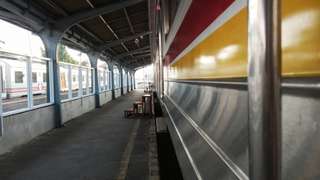
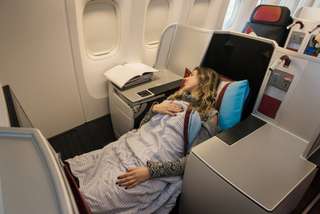









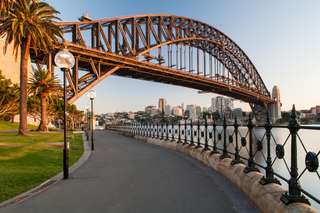




















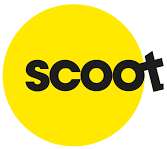









































 Facebook
Facebook Instagram
Instagram TikTok
TikTok Youtube
Youtube Twitter
Twitter Telegram
Telegram WhatsApp
WhatsApp
